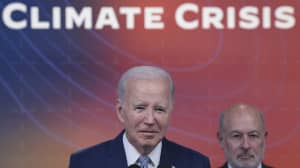Political pressures on the U.S. Federal Reserve and President Joe Biden’s economic agenda have delivered a painful blow — inflation still above the Fed’s 2% target, high interest rates and declining living standards.
COVID-induced supply chain disruptions can be blamed for about half of the surge in inflation that began in early 2021. Most of the rest can be pinned on the $4.6 trillion in COVID emergency aid and stimulus spending — especially Biden’s $1.9 trillion American Rescue Plan and the Fed printing too much money to purchase much of the resulting surge in federal debt.
In 2021, Biden delayed reappointing Fed Chair Jerome Powell as the end of his term approached. Powell responded by saying the U.S. inflationary surge was transitory and repeatedly expressed skepticism of a link between expanding the money supply and inflation.
Were these tragic errors of judgement or just political expediency? In any case, the Fed was slow to respond to rising prices and inflation peaked at 8.9% in June 2022. Ultimately, the Fed raised interest rates from near-zero to just above 5%. As importantly, it started reducing the size of its balance sheet and the money supply — but much too slowly.
From the fourth-quarter of 2019 to the first-quarter of 2023, real GDP had recovered and was up 5.6%. The money supply, as measured by currency in circulation, household and business checking accounts and money market deposits, was still up 38.7% — a difference of 33%. Given that scenario, it’s lucky that prices only jumped 17% over that period.
After its meeting later this week, the Fed will likely raise the benchmark overnight lending rate for banks by at least one more quarter-point. Since the worst days of the recent inflation, China’s factories have reopened, West Coast ports have resolved labor problems and ocean shipping rates have eased. The shift in demand from goods to services and efforts to diversify sourcing from China are also helping drive down the cost of ordinary household items imported from Asia.
The Fed may get additional help as falling rents work into the consumer price index — shelter is the largest component of the CPI. In June, headline CPI inflation pulled back to 3.0%, but the Fed should be cautious not to become complacent.
The Great Inflation that former Fed Chair Paul Volcker slayed in the early 1980s was a decade-and-a-half in the making. Inflation peaked in 1966, 1970 and 1974 at 3.8%, 6.4% 12.1%, respectively. Each time, the central bank raised rates to curb inflation but then pulled back to stave off a weakening economy. Each time, inflation fell only to come roaring back and reach a new high. Ultimately, inflation rose to 14.6% in early 1980.
Now the U.S. and European economies are slowing. Limiting interest rate increases may rescue the U.S. economy from a prospective recession, but it may also break inflation’s downward trajectory and encourage it to reignite later.
Read: China is feeling the pinch from a weakening global economy and U.S. restrictions
Advocates for easy-money policies, who once shouted from the gallery, are now inside the Fed’s policymaking committee. As the Fed hesitates on interest rates in search of a soft landing — much in the manner of weak-kneed Fed policy in the 1960s and 1970s — Chicago Fed President Austan Goolsbee, a Biden appointee, says that “mocking the immaculate deflation is a mistake because there was a large component that was immaculate inflation.”
The Fed boosting the money supply by 39% makes the paternity of inflation no mystery. Biden’s Infrastructure, CHIPS and Science and Inflation Reduction Acts will increase the federal deficit to $1.5 trillion this year and next from $984 billion in 2019 and boost aggregate demand.
The transition to electric vehicles will dramatically raise new car prices, the slowdown in new home construction during COVID and rising interest rates will impose a tighter housing market in 2024, and rising temperatures and drought will continue to pressure food prices.
Either the Fed maintains high interest rates and risks a Volckeresque recession, or inflation may abate for a time but then soar again. This is not good for ordinary workers. During eight of first nine quarters of the Biden Presidency, wages were up less than inflation. Falling real wages will be a big issue in the 2024 U.S. presidential election.
For equity investors, prospects are better. Large corporations are adapting to a moderate inflationary environment and stablized their profit margins. As we emerge from whatever slowdown lies ahead, the overall outlook for equities will be positive. Timing is always tough; expanding stock holdings a bit each month remains a good long-term investment strategy.
Peter Morici is an economist and emeritus business professor at the University of Maryland, and a national columnist.
Plus: Why the Fed’s fumble on inflation leaves the economy vulnerable to stagflation







